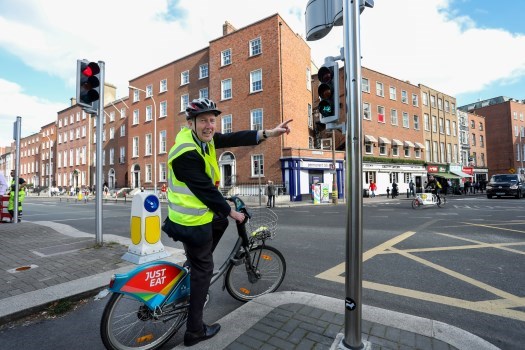
The Minister for Transport, Tourism and Sport Shane Ross confirmed an additional €400,000 of funding is being made available to Dublin City Council for investment in cycling safety infrastructure.
Speaking at today’s announcement Minister Ross commented
I want to encourage more people to cycle and I realise that safety is a concern to many, so I am continuing to invest in safety measures for cyclists. This €400,000 will improve safety for cyclists at 40 key junctions across Dublin City Centre and is a great example of my Department and the National Transport Authority working with local authorities to improve cycling and walking infrastructure generally.
This investment will be used to fund Dublin City Council’s installation of smart cyclist detection equipment at 40 key junctions around Dublin. This new traffic management feature aims to make busy junctions safer for cyclists by using smart technology to regulate traffic more effectively. In particular these measures will help alleviate concerns of cyclists regarding collisions and crossing times at busy junctions.
Minister Ross stated
This funding is in addition to the €110million I have already secured for the development of cycling and walking infrastructure across the country over the next 4 years. Furthermore, significant investment is planned under the BusConnects programme in Dublin, which will deliver around 200km of, where possible, segregated cycle paths.
The Department is also a key sponsor of Velo-City 2019 and is working closely with Dublin City Council (DCC), who will host the event.
The Minister said
I am delighted to support this prestigious event and look forward to welcoming the conference, delegates and sponsors back to Dublin in June of next year.
The Minister also wished the NTA’s Smarter Travel Team success for their ‘Reboot your Commute’ campaign that is launching tomorrow and thanked the National Transport Authority and DCC for their continued commitment to improving infrastructure.
Notes to Editors:
The Department of Transport, Tourism and Sport invests heavily in cycling safety with programmes including the Green Schools Travel Flag programme and CycleRight which last year delivered cycling training to over 15,000 students nationwide.
Velo City website https://www.velo-city2019.com/
Cycle safety at Signalised junctions.
A number of concerns have been raised regarding cyclists safety at signalise d intersections within the Dublin City area. These fall into three main categories.
1. Cyclists not have enough time to cross a junction before opposing signals go green.
2. Cyclists colliding with left turning vehicles
3. Lack of information regarding numbers of cyclists at different junctions.
Within the Dublin City Council area traffic signals are set to operate with safety timings which are normally calculated using the UK Department for Transport advisory leaflet 1/06. The safety times referred to are the “intergreens” i.e. time from end of end of green on one approach to start of green on an opposing approach. It is assumed vehicles are travelling at a uniform speed at or close to the posted speed limit.
This approach allows for safety at junctions for vehicular traffic but raises issues when the proportion of bicycles at an intersection starts to rise due to the relatively slow speed of cyclists in an urban environment and the variability of speed across types of cyclists. In Copenhagen the average speed of cyclists is 15km/hour and this seems to be replicated in several cities around the world. The issue therefore for a cyclist is that on a 50km/h road they are travelling through the intersection at a third of the speed of cars and take three times as long to safely pass through.
One approach therefore is to change the calculations at junctions from 50km/h to 15km/h and add on the additional intergreen time, however this is wasteful for a number of reasons :-
1. The longer the intergreen time the less green time available for Trams, Buses , Taxis and general traffic and so increasing congestion and journey times for public transport.
2. The issue of intergreens only arises if a cyclist is travelling through the junction at the end of their green signal, at all other times it makes no difference.
3. There is a lack of information about the proportion of cyclist using a junction at different times of the day. For example during the morning peak due to the numbers of cyclists using a junction it may be appropriate to alter the safety timings to favour cyclists but not outside these times.
Dublin City Council therefore propose to start installing two types of detection at junctions within the Dublin City area. :-
1. Inductive loop technology where there are segregated cycle tracks.
2. “Smart “ thermal imaging detectors which can automatically detect and distinguish cyclists with mixed traffic lanes.
Initially the installation would be at the physically big junctions in the city centre and surrounding areas and especially the junctions in the 60km/h areas. It is now therefore proposed to identify 40 junctions within the City Council area where this detection can be installed and where benefits for cyclists can be quickly achieved, works will commence in 2018. This would be a phase 1 list with work then commencing on a phase 2 list once the benefits of this approach have been quantified and realised.